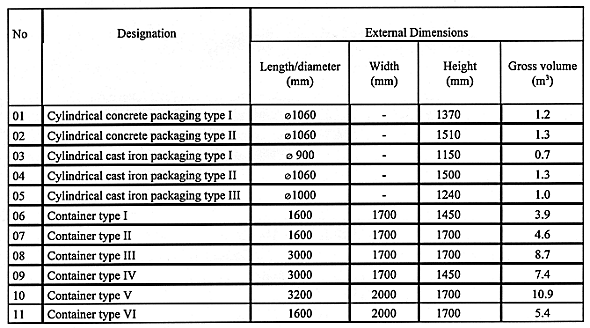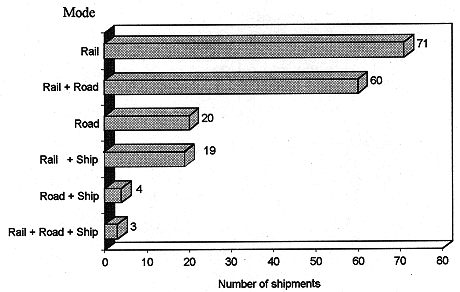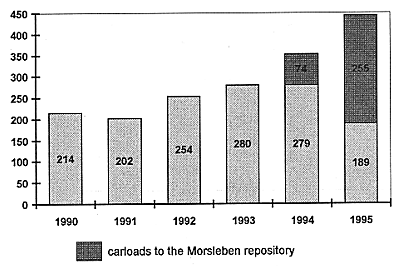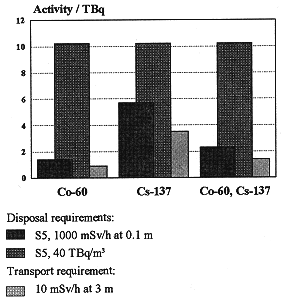
F. Nitsche
Bundesamt für Strahlenschutz
U.
Alter
Bundesministerium für Umwelt, Naturschutz und Reaktorsicherheit
ABSTRACT
The transport of low and intermediate level radioactive waste has to be performed in compliance with the modal transport regulations for road and rail in Germany which are consistent with the Regulations for the Safe Transport of Radioactive Material of the International Atomic Energy Agency (IAEA), Safety Series No. 6 (As Amended 1990). The main criteria for such shipments of low and intermediate level waste resulting from these transport regulations will be described regarding waste classification, waste limitation and waste packaging. Based on this regulatory framework an overview on the low and intermediate level waste shipments in Germany will be given taking into account different types of waste packages and different modes of transport for the main transport routes between nuclear power plants, conditioning facilities, interim storage facilities and the final repository.
A waste package has finally to be shipped to the repository. Therefore the described waste package criteria resulting from transport regulations will be discussed in relation to waste acceptance requirements resulting from disposal. In Germany such waste acceptance requirements exist for the Morsleben and Konrad repository. By comparing these criteria with transport criteria some conclusions can be drawn regarding limitations and optimizations of waste package concepts as well as consistency of regulatory requirements. Such considerations seem to be necessary to optimize waste management processes from the conditioning to the final disposal, including transport.
Finally some aspects of the latest revision and future development of the IAEA Transport Regulations, Safety Series No. 6 will be given in respect to low and intermediate level waste transport. This process needs input from waste management activities to keep the IAEA Transport Regulations up to date based on practical needs and to ensure the high level of safety for waste shipments also in the future.
INTRODUCTION
Low and intermediate level radioactive waste in Germany arises from research and development centers, nuclear power plant operation, decommissioning, the nuclear fuel cycle industry and applications of radioisotopes in medicine, industry and research. According to the German disposal concept, all radioactive waste has to be emplaced in a repository constructed and operated in deep geological formations. Two sites are presently considered for disposal of low and intermediate level waste
Depending on the type of waste, a waste package can be transported directly to such a repository, but usually other transport activities are necessary before, like transport to a conditioning or interim storage facility. This paper describes the main regulatory requirements for such shipments and gives an overview on the transportation of low and intermediate level waste in Germany.
A waste package which has finally to be shipped to the repository must also meet the waste acceptance requirements of the Morsleben or Konrad repository. Therefore a comparison is given between main disposal and transport requirements. In particular, criteria on waste form, radionuclide inventory and packaging are considered to derive the restricting parameters for the waste package design or to optimize the waste package concept.
Finally some aspects of the latest revision process of the IAEA Transport Regulations are discussed in respect to low and intermediate level waste transport.
REGULATORY REQUIREMENTS FOR WASTE TRANSPORT
The radioactive waste in Germany has to be shipped according to the GGVS (1) on road and the GGVE (2) on rail, which are consistent with the IAEA Transport Regulations, Safety Series No. 6 (3).
The provisions for low specific activity material (LSA) of Safety Series No. 6 (SS6) are mainly applied in case of waste shipments, which leads to the following requirements for the relevant waste packages.
The waste form has a limited specific activity and can be assigned to LSA-II or LSA-III category according to para 131 (b) or (c) of SS6.
In the case of LSA-II, the activity is distributed throughout the waste form and the estimated average specific activity does not exceed 10-4 A2/g (A2-radionuclide specific limit tabulated in SS6).
In the case of LSA-III, it is required that
LSA-II and LSA-III material has to be shipped in industrial packagings Type 2 and 3 (IP-2, IP-3) according to para 426 of SS6. They must meet the general design requirements (para 505-514) and, in addition, in case of IP-2 the free drop test (para 622) and the stacking test (para 623), and in case of IP-3 all Type A design requirements and Type A tests for solids. By these tests it is demonstrated that the package can withstand normal conditions of transport. Alternatively freight containers may also be used as IP-2 or IP-3 provided they meet the general design requirements and the ISO 1496/1-1978 requirements ("Series 1 Freight containers - Specifications and Testing - Part 1: General Cargo Containers") according to para 523.
The total quantity of LSA material in a single IP-2 or IP-3 package shall be so restricted that the external radiation level at 3 m from the unshielded material does not exceed 10 mSv/h (para 422). In addition, in case of combustible solid LSA-waste in IP-2 or IP-3 the total activity per conveyance is limited to 100 A2 (para 427).
IP-2 or IP-3 waste packages must not exceed the following external radiation and contaminations limits:

The nonfixed surface contamination is limited to
If radioactive waste materials can be classified as surface contaminated object SCO-II according to para 144 of SS 6 then also IP-2 packagings have to be used with the requirements as described above for LSA-material.
WASTE SHIPMENTS IN GERMANY
Shipments of low and intermediate level waste are taking place between the waste producers like nuclear power plants, the nuclear fuel cycle industry and the applicants of radioisotopes in medicine, industry and research, and the conditioning facilities, interim storage facilities and the final repository Morsleben. The main waste stream results from nuclear power plant operation. For these waste shipments a good data base is available because a special computer control and documentation system for waste flow tracking and quality assurance was established by the electrical power companies in Germany. A overview on the shipments of such wastes resulting from nuclear power plant operation is given in the following.
Transport Organization and Responsibilities
The transport of radioactive waste in Germany is centralized and coordinated by the German Railway Company (Deutsche Bahn AG). The conditioning of radioactive waste is carried out by the Gesellschaft für Nuklear Service (GNS). The German Railway Company is responsible to perform the transport activities and the GNS is responsible for the conditioning of radioactive waste originating from nuclear power plants.
There are independent inspection authorities for rail and road transport to ensure that the provisions of the Transport Regulations are met in practice.
Transport Systems
Standardized packagings are used for the transport of radioactive waste. In general a shipping unit consists of a 20' freight container which can be shipped by rail, road or sea and which may contain drums or other reusable or non-reusable package types.
The GNS operates a comprehensive transport system with the following three main components (4):
Table I Standardized Packagings for the Disposal of Radioactive
Waste for the Konrad repository (5)

Another transport system for the shipment of waste to the Morsleben repository is operated by the company Nuclear Cargo + Service GmbH (NCS) (6). 20'-ISO containers equipped with special tie-down elements are used to transport drums or various standardized packagings of the types primary container (PC) and drum container (FC) (Table II). All types of PC and FC are reusable which is different from the "lost" packagings (Table I) for the Konrad repository. They are of cylindrical shape and made from steel. In case of FC 40, 70 and 100 there is a sandwich shielding wall design of steel-lead-steel. They provide different shielding capabilities.
Table II Standardized Reusable Packagings of the Types Primary
Container (PC) and Drum Container (FC) for the Morsleben Repository (5)

Shipments from Nuclear Power Plants to Waste Handling and Interim Storage Facilities
An overview on the number of shipments of radioactive waste from nuclear power plants to waste handling or interim storage facilities is given in Fig. 1. These data were derived for 1992 with a total of 177 shipments. The shown mode depending distribution is supposed to be representative also for the following years. Railway shipment is the dominant mode of transport. Almost 90 % of all shipments include railway.

Fig. 1 Waste shipments for various
transport modes in 1992
Data for waste shipments of the German Railway Company between 1990 and 1995 are shown in Fig. 2. There is a slight increase of the total carload numbers per year up to 1993. The strong increase in 1994 and 1995 reflects the fact that the Morsleben repository was put in operation again in January 1994 (see next section). The resulting waste shipments to the repository are also included in the total carload numbers per year. If these are eliminated, as shown in Fig. 2, the remaining carload number for shipments of radioactive waste from nuclear power plants to waste handling or interim storage facilities decreases considerably to 189 in 1995. Such shipments are reduced by increasing the number of shipments to the repository.

Fig. 2. Waste shipments by rail
1990-1995 (number of carloads per year)
Shipments to the Morsleben repository
The Morsleben repository has been back in operation since 13 January 1994. The number of shipments per year from this date on is given in Table III together with data on waste volume.
The Morsleben repository has no rail access. The waste is shipped by rail as close as possible to the Morsleben site (to marshalling yard Magdeburg-Sudenburg, about 50 km away), reloaded on a truck and then shipped by road to the repository. About 90 % of all shipments to the repository are performed by the combined rail/road transport and 10 % by road only.
Table III Shipments of radioactive waste to the Morsleben
repository

COMPARISON BETWEEN TRANSPORT AND DISPOSAL CRITERIA
A waste package has finally to be shipped to the repository for final disposal and must therefore meet both transport and disposal requirements. In comparing both, the restricting waste package parameters can be derived which will determine the waste package design. In Germany such waste acceptance requirements exist for the Konrad and Morsleben repository as described in (5). By comparing these with transport requirements the following conclusions can be drawn concerning external radiation and surface contamination, waste form, activity inventory and packaging level as main criteria for a waste package.
External Radiation and Surface Contamination
These criteria are limited in a similar way, so that in most cases compliance with transport requirements results also in compliance with disposal needs for the Konrad as well as Morsleben repository.
Waste Form
Basically each waste form may be categorized as LSA-material provided that compliance with the described definition can be demonstrated. The main criterion besides the limited leachability of LSA III is the sufficient activity distribution throughout the waste product. This criterion, for example, is already met by disposal needs in case of the waste form group 05 of the Konrad repository or waste of quality level 6 of the Morsleben repository (5). In the other cases, this has to be checked in addition to the disposal requirements for the waste form.
Activity Inventory
The permissible activity inventory of the waste package is determined by the most restrictive limit resulting from disposal and transport requirements. For transport these limits have to be derived from the requirements for specific activity, unshielded dose rate at 3 m distance and total activity per conveyance depending on the radionuclide mixture, the material, and the volume of the waste.
For the Konrad repository the disposal limits on package contents concerning normal operation, incidents, decay heat and criticality have to be considered and compared with the transport limits. The resulting permissible activity inventory of the waste package is obtained depending on the radionuclides, the form and packaging group of the waste. In case of Co-60 and Cs-137 as relevant radionuclides of waste originating from nuclear power plant operation, for example, the total activity of the waste package is mainly restricted by the unshielded dose rate limit of 10 mSv/h from transport and by decay heat limits from disposal (7). In principle, compliance with this 10 mSv/h criterium is to be expected for waste shipments to the Konrad repository by meeting the external radiation limits of the package, because the standardized Konrad packagings have a limited shielding capability (7).
For the Morsleben repository solid wastes are classified into 5 Radiation
protection Groups (S1-S5) depending on limits on dose rate and
 /-
/- activity concentration. Solid
wastes of the radiation groups S1 to S4 will also meet transport requirements
due to limited doses rates and
activity concentration. Solid
wastes of the radiation groups S1 to S4 will also meet transport requirements
due to limited doses rates and  /-
/- -activity concentrations. In the
upper range of S5-wastes the activity inventory for
-activity concentrations. In the
upper range of S5-wastes the activity inventory for
 -emitting radionuclides will
be restricted by the unshielded dose rate of 10 mSv/h at 3 m distance from
transport. A concreted 200-l drum (
-emitting radionuclides will
be restricted by the unshielded dose rate of 10 mSv/h at 3 m distance from
transport. A concreted 200-l drum ( = 2,35 g/cm3)
containing Co-60 with the maximum S5 dose rate for example exceeds the 10 mSv/h
criterion by a factor of 1.6. If the maximum S5-
= 2,35 g/cm3)
containing Co-60 with the maximum S5 dose rate for example exceeds the 10 mSv/h
criterion by a factor of 1.6. If the maximum S5- -activity concentration is assumed,
this criterion will be exceeded even by a factor of about 12, as shown in Fig.
3.
-activity concentration is assumed,
this criterion will be exceeded even by a factor of about 12, as shown in Fig.
3.

Fig 3. Activity limitations of a
concreted 200 litre drum package containing Co-60 and Cs-137 according to
transport and disposal requirements for the Morsleben repository.
Packaging
For the Konrad repository the IP-2 or IP-3 qualification of the package according to transport requirements gives high credit to meet the basic package requirements from disposal. In particular, it meets the mechanical integrity requirement under impact velocity condition of 4 m/s for waste container class I up to a package mass of 10 metric tons. In addition to transport packaging requirements, for waste container class I qualification for disposal, the package behavior under fire conditions (800°C, 1 h) has to be taken into account as well as for class II qualification together with the 5-m drop test (7).
For the Morsleben repository the required qualification of the reusable packagings according to the transport requirements is also sufficient for disposal needs.
FUTURE DEVELOPMENT OF TRANSPORT REGULATIONS
The shipments of low and intermediate level waste are mainly performed according to the provision for LSA material and SCO of the IAEA Transport Regulations, Safety Series No. 6, 1985 Edition.
At present this 1985 Edition is in force and applied worldwide. Based on a 10 years review and revision process a new version of the IAEA Transport Regulations, the 1996 Edition, is published now. It is expected to come into force by the modal transport organizations in 1999. Concerning the provisions for LSA material and SCO only minor changes were introduced so that the current material and packaging classification remains also in the future. Increased attention is directed to quality assurance aspects in design, testing, maintenance and use of the waste transport packages.
This process of review and revision of the IAEA Transport Regulations will continue to keep them up to date. This process needs input from and correlation with waste management / waste disposal activities.
CONCLUSIONS
The transport of low and intermediate level waste in Germany is performed in accordance with the provisions of the IAEA Transport Regulations. There are transport systems available which provide flexibility in using various types of non-reusable and reusable packagings in connection with 20' containers as shipping units. Experience demonstrates the high level of safety for such shipments.
For radioactive waste intended for disposal in a repository, both transport and disposal requirements have been taken into account in the qualification of the waste package. In particular, requirements on waste form, radionuclide inventory, and packaging have to be examined to derive the limiting parameters for the waste package design. Depending on the criteria considered credit can be taken from transport as well as from disposal requirements. Such considerations seem to be helpful to optimize waste-management processes from the conditioning to the final disposal including transport.
The future development of the IAEA Transport Regulations needs input from and correlation with waste management / waste disposal activities to keep them up to date based on practical needs and to ensure the high level of safety for waste shipments also in the future.
REFERENCES